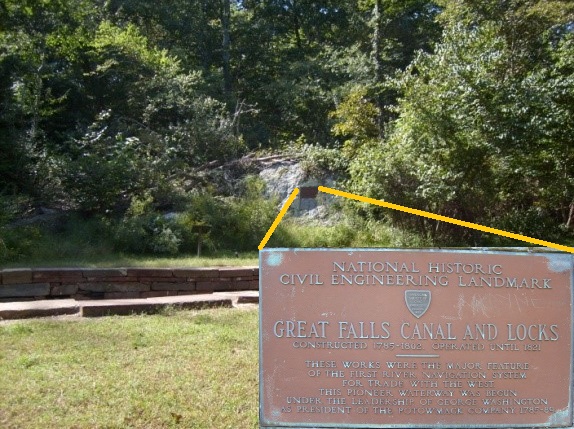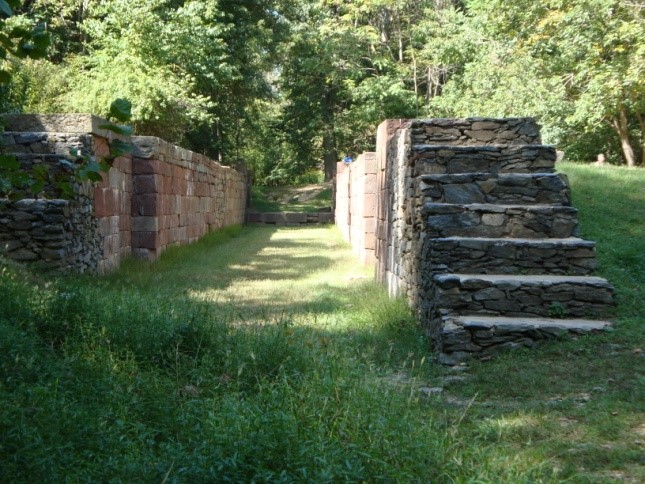(Geographic Coordinates: Latitude N 38° 59.424, Longitude W 077° 14.970)
 By the middle of the eighteenth century, settlement along the Potomac River west of the Allegheny Mountains was well under way. In 1749, the Ohio Company was established to develop the growing valley and capitalize on the untapped fur trade with the Indians by utilizing the Potomac as a route to the west.
By the middle of the eighteenth century, settlement along the Potomac River west of the Allegheny Mountains was well under way. In 1749, the Ohio Company was established to develop the growing valley and capitalize on the untapped fur trade with the Indians by utilizing the Potomac as a route to the west.
One of the first to become interested in a navigable Potomac waterway was George Washington. In his teens, he aided in surveying the holdings of Lord William Fairfax along the upper Potomac. As early as 1754, on his return from his defeat at Fort Necessity, Washington made a report proposing a project by which the Potomac River might be made navigable from tidewater to a point west of Cumberland, Maryland, and then connect by trans-mountain roads with streams leading to the Ohio River.
 The Patowmack Company was formally organized at a meeting of the stockholders on May 17, 1785. Washington was elected its first president, and James Rumsey, the early experimenter with the steamboat, engaged as the chief engineer. The proposed project was to have a series of short by-pass canals to skirt the falls which occurred at several locations along the course of the river. There were to be five altogether at House's Falls, Harper's Ferry, Seneca Falls, Great Falls, and Little Falls.
The Patowmack Company was formally organized at a meeting of the stockholders on May 17, 1785. Washington was elected its first president, and James Rumsey, the early experimenter with the steamboat, engaged as the chief engineer. The proposed project was to have a series of short by-pass canals to skirt the falls which occurred at several locations along the course of the river. There were to be five altogether at House's Falls, Harper's Ferry, Seneca Falls, Great Falls, and Little Falls.
 The four locks at Little Falls, constructed in 1795, were the first to be completed. Work began on the locks at Great Falls and was not finished until 1802. The system at Great Falls consisted of five locks, each one hundred feet in length and walled with large blocks of hand-hewn sandstone. It was necessary to blast and cut a deep cleft through the solid rock cliff of the Potomac River’s Mather Gorge rising seventy-seven feet from the river level below to the river level above the Falls. The rock blasting was one of the first uses of black powder. The passage through the rock wall had to be large enough to accommodate loaded bateaus: a channel at least twelve feet across. The typical bateau (flat bottom boat) was anywhere between fifty to seventy-five feet long and five feet in width and carried up to 20 tons of cargo. The total lift was seventy-seven feet distributed through the locks with the greatest lift in any one lock of nineteen feet.
The four locks at Little Falls, constructed in 1795, were the first to be completed. Work began on the locks at Great Falls and was not finished until 1802. The system at Great Falls consisted of five locks, each one hundred feet in length and walled with large blocks of hand-hewn sandstone. It was necessary to blast and cut a deep cleft through the solid rock cliff of the Potomac River’s Mather Gorge rising seventy-seven feet from the river level below to the river level above the Falls. The rock blasting was one of the first uses of black powder. The passage through the rock wall had to be large enough to accommodate loaded bateaus: a channel at least twelve feet across. The typical bateau (flat bottom boat) was anywhere between fifty to seventy-five feet long and five feet in width and carried up to 20 tons of cargo. The total lift was seventy-seven feet distributed through the locks with the greatest lift in any one lock of nineteen feet.
The Patowmack Canal and Locks was a first step for American canal building and it played a significant role in the development of canal engineering in this country. It was designated a "National Historic Civil Engineering Landmark" by ASCE in 1969.
